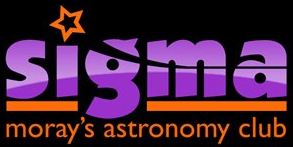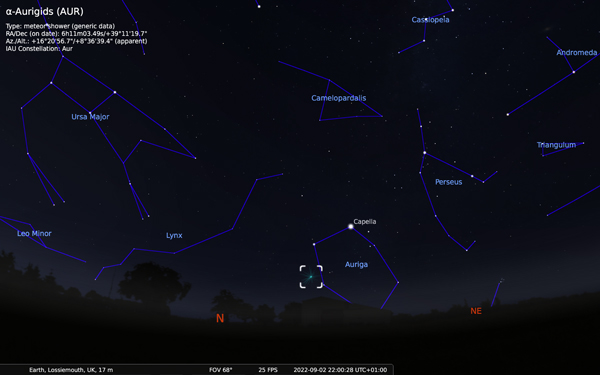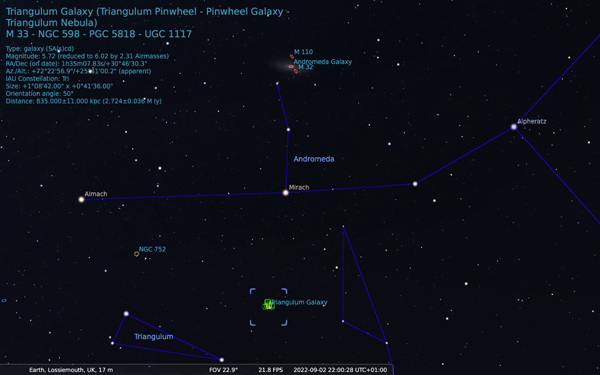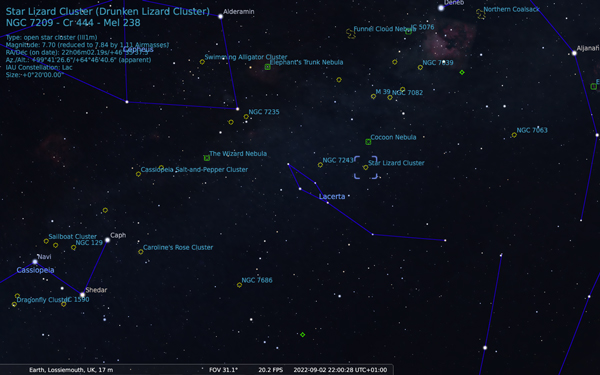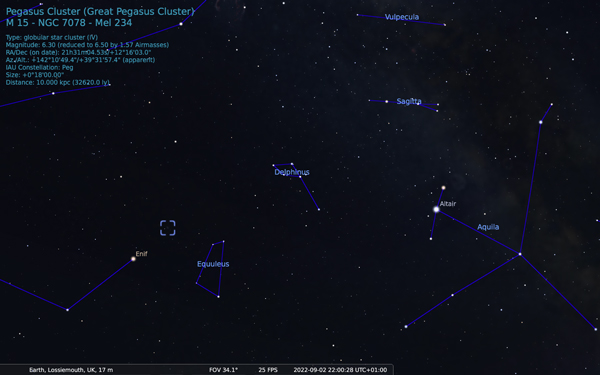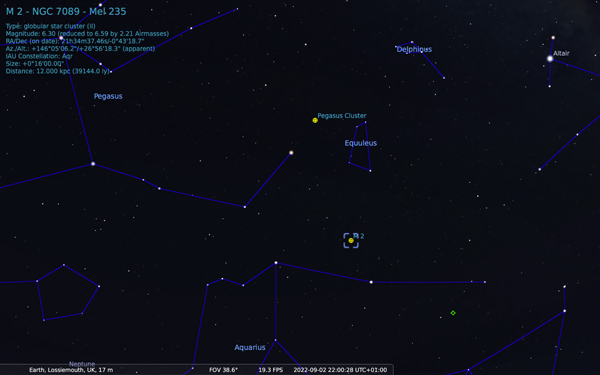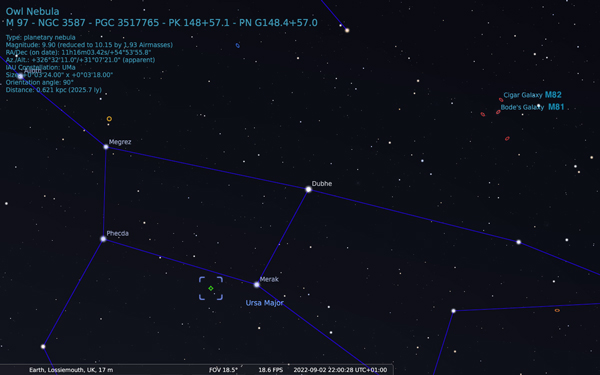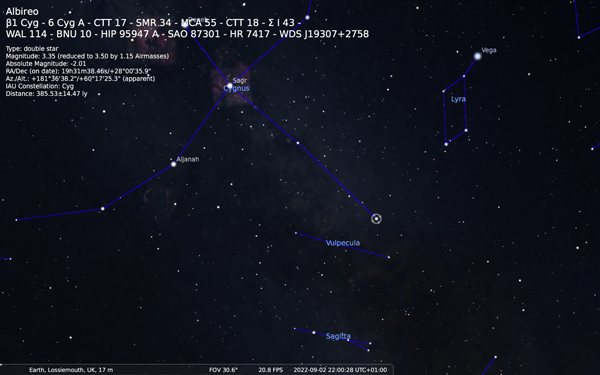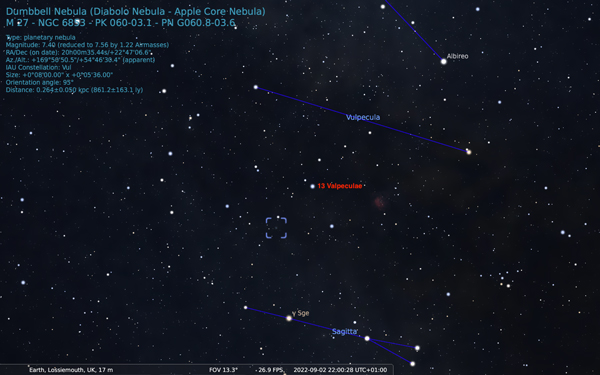Moray Sky at Night September 2023

Image courtesy of https://moonphases.co.uk
Moon Phases September 2023
Full Moon 31st August,
Last quarter 6th September,
New moon 15th,
First quarter 22nd,
Full Moon 29th September ’23
The Planets
Mercury – Generally lost in the morning twilight, but comes to greatest western elongation of 17.9° at mag. -0.5 on 22 Sept ’23.
Venus – In Cancer, visible in the morning sky at mag. -4.7.
Mars – In Virgo and is lost in the evening twilight.
Jupiter – In Aries, begins retrograde motion in early September at mag. -2.6 to -2.8.
Saturn – Is in Aquarius and still retrograding at mag. 0.5.
Uranus – Is just inside Aries at mag. 5.9.
Neptune – In Pisces at mag. 7.8 and comes to opposition on 19 Sept ’23.
MORAY’S NIGHT SKY – 15th September 2023 @22:00 hrs GMT
Thanks to Chris Peat at Heavens-above.com for use of the star map
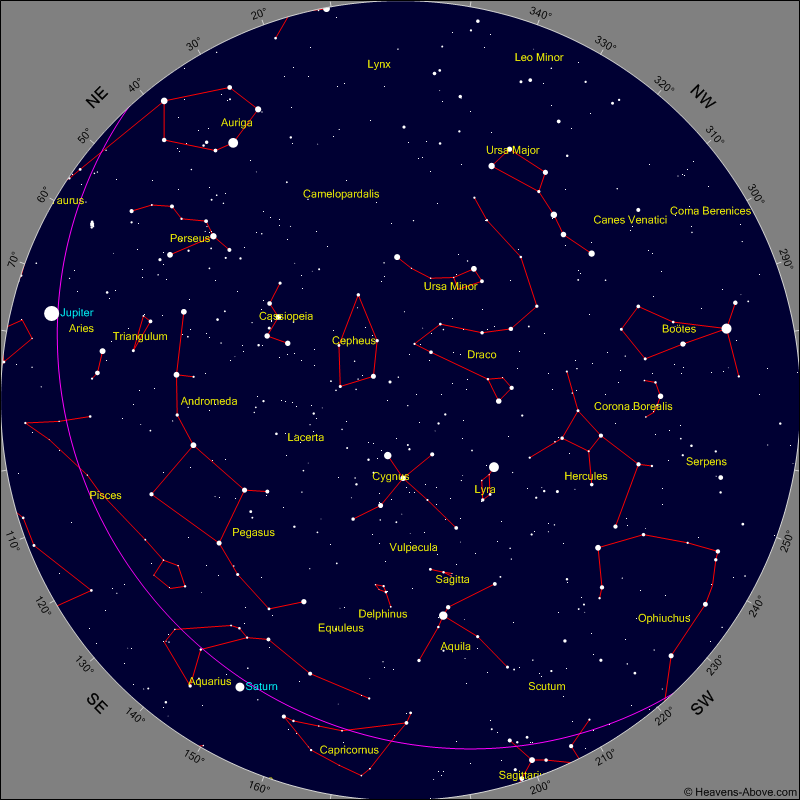
Meteor Showers
Alpha Aurigids are active 25 Aug to 06 Sept ’23 and are at their maximum around 1st September ’23 although the full Moon will interfere. A weak shower as a rule, occasional outbursts have been recorded. This meteor shower isn’t visible until late at night, around 11 p.m. in a north easterly direction. Over the course of the night, the radiant point will rise higher into the sky. These meteors derive from comet C/1911 N1 (Kiess).
September Overview
At last, we have planets to observe at a reasonable hour for those averse to early rising. As the days shorten, a procession of favourite solar-system quarry becomes available – firstly Saturn, then Neptune, Jupiter, and Uranus. During the warm late-summer nights, the Milky Way offers an array of treats for the deep-sky observer, so all tastes are catered for. The Summer Triangle is now high in the southwest, made up of three first-magnitude stars: Vega in Lyra, Deneb in Cygnus, and Altair in Aquila. Vega (alpha Lyrae) is a brilliant blue-white treasure. Lyra is a small but perfectly formed pattern that contains the famous Ring Nebula (Messier 57), the rather overlooked globular cluster Messier 56, and the ‘Double Double’, epsilon Lyrae (to the north of Vega). This is a wide pair of stars, within which each component is again a closer double and a good test for small telescopes. The wide pair is easily split using binoculars, as the two binaries are 208 arcseconds apart. Epsilon-1 (ε1) has stars of magnitude 4.7 and 6.2, separated by 2.6 arcseconds; epsilon-2 (ε2) has stars of magnitude 5.1 and 5.5, slightly closer at 2.3 arcseconds. Rising high in the southeast this month is Pegasus with its unmistakable square shape that makes up the body of the flying horse. Pegasus and Andromeda are well clear of the horizon with M31 ideally situated for viewing. Some 15° below M31 lies M33, the Triangulum Galaxy. Lower in the sky, the appearance of the Pleiades is an indicator that autumn is almost upon us.
Above Andromeda is the small group of stars that forms Lacerta, the lizard. This constellation ranks 58th in order of size and contains few bright deep sky objects. However, there are a number of open clusters, with NGC 7243 & NGC 7209 being the most obvious at magnitudes +6.4 & +6.7 respectively.
Looking southwards the most easterly of the three members of the Summer Triangle, Deneb, has reached the meridian. Directly south of Deneb are the small constellations of Delphinus, the dolphin and Equuleus, the small horse. Both of these belong to the original list of 48 constellations devised by Ptolemy in the second century AD. Whilst, with a little imagination, it might be possible to envisage the stars of Delphinus resembling a leaping dolphin.
Looking a little further south – but still on the meridian – brings us to Aquarius which contains the second object on Charles Messier’s list, M2. This is a fine globular cluster with a magnitude of +6.3.
To the north, the ‘nose’ of Ursa Major is just on the meridian immediately below the pole, with the popular pair of galaxies M81 & M82 still moderately well placed from the UK.
The main body of Auriga is now clearing the horizon along with the brilliant Capella, which will ride high in the sky in the depths of winter. Above the pole are Draco and Cepheus. The latter of these contains a variety of open clusters, the brightest being NGC 7160 at magnitude +6.1. It also accommodates the well-known Elephant’s Trunk Nebula within its boundaries.
September’s Object Challenge
This challenge this month is an easy one and one of Pete’s favourite Deep Sky Objects, M27 The Dumbbell Nebula. To find M27 find Albireo in Cygnus drop down to the constellation of Sagitta (The Arrow). Go to the star at the head of the arrow eta (h)Sagittae, in the constellation of Valpecula locate the star 13 Valpeculae which is not easy at mag 4.5. The Dumbbell Nebula is located approximately half way between these two stars.
ISS
The ISS is a visible morning object from 27th August until 08th September ‘23.
Then from the 16th it will be visible in the evening sky until the 29th of September ‘23.
For more information on exact timings of ISS visibility (and all things celestial), go to
https://www.heavens-above.com/PassSummary.aspx?satid=25544
If you create a free account and enter your location it gives you a precise timings and starmaps.
Another website for astronomy information at: www.in-the-sky.org
Clear skies!
Mick
